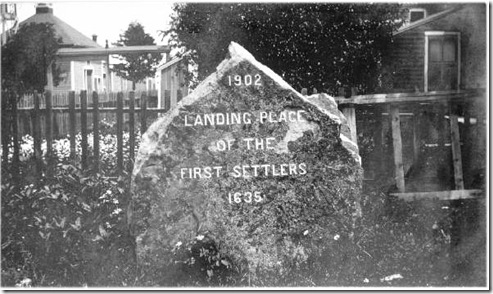Landing Place of the First Settlers
Commemoration of the arrival of the first settlers in Newbury, MA.
~Merrill.genealogy
From a Brief History of Newbury:
The settlers of Newbury were not religious enthusiasts or pilgrims who fled from religious persecution in England. They were substantial, law abiding, loyal English tradesmen, of that staunch middle class that was the backbone of England.
Those that settled Newbury came at different times and on different ships, between the end of April, 1634 and July, 1635. In one of the first ships arriving in 1635, came Thomas Parker a minister along with a small company of settlers. They went first to Agawam (Ipswich) and later along with their countrymen, who came from Wiltshire, England, to Newbury.
The first settlers came by water from Ipswich, through Plum Island Sound, and up the Quascacunquen River, which was later renamed the Parker River. These settlers came to Newbury in May or June of 1635. Ships from England began to arrive almost immediately with cattle and more settlers. Governor Winthrop, in his history of New England under the date of June 3, 1635, records the arrival of two ships with Dutch cattle along with the ship "James", from Southampton bringing more settlers.
Newbury was, therefore, begun as a stock raising enterprise and the settlers came to engage in that business and to establish homes for themselves. In total fifteen ships came in June and one each in August, November and December bringing still more families to the settlement.
There is no record of how many families arrived in the first year. Houses were erected on both sides of the Parker River. The principal settlement was around the meeting house on the lower green. The first church in Newbury could not have been formed before June, as some of those recorded at its formation are not recorded as having arrived until June.
In the division of land the first settlers recognized the scripture rule, "to him that hath shall be given," and the wealth of each grantee can be estimated by the number of acres given him.*
When they arrived in Massachusetts, the settlers found that the state had established the Congregational form of religion. Everyone was taxed to support the Congregational Society and was commanded to attend worship at the meeting house. The Reverend Thomas Parker was a member of the stock raising company and was also the minister of the settlers.
The outlying settlers had a long journey to the meeting house. The congregations were in danger of attacks from Indians and wild beasts on their way to and from worship. There was a constant dread of attack during the time of services and all able bodied inhabitants were required to bring their weapons to church. Sentinels were posted at the doors.**
In spite of the hardship and danger, the population steadily increased in number and gradually improved its worldly condition.
*a statement of practice which furthers the argument that Robert Adams was not a tailor.
**reinforces the view of Robert’s stature in Newbury, allowed as he was to establish his property so far from the settlement.





Love this, and very interesting. Good job on research by son Edward